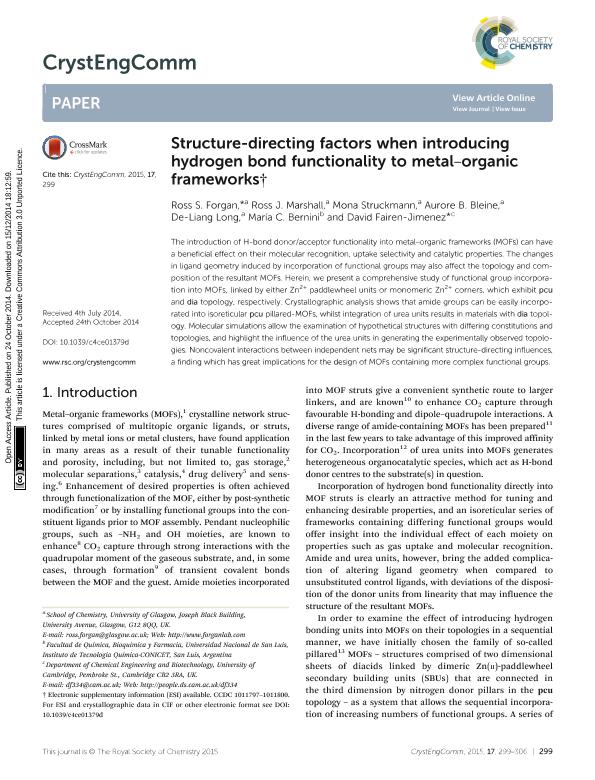Mostrar el registro sencillo del ítem
dc.contributor.author
Forgan, Ross S.
dc.contributor.author
Marshall, Ross J.
dc.contributor.author
Struckmann, Mona
dc.contributor.author
Bleine, Aurore B.
dc.contributor.author
Long, De Liang
dc.contributor.author
Bernini, Maria Celeste

dc.contributor.author
Fairen Jimenez, D.
dc.date.available
2016-05-27T19:29:26Z
dc.date.issued
2014-10
dc.identifier.citation
Forgan, Ross S.; Marshall, Ross J.; Struckmann, Mona; Bleine, Aurore B.; Long, De Liang; et al.; Structure-directing factors when introducing hydrogen bond functionality to metal?organic frameworks; Royal Society of Chemistry; Crystengcomm; 2015; 17; 10-2014; 299-306
dc.identifier.issn
1466-8033
dc.identifier.uri
http://hdl.handle.net/11336/5888
dc.description.abstract
The introduction of H-bond donor/acceptor functionality into metal-organic frameworks (MOFs) can have a beneficial effect on their molecular recognition, uptake selectivity and catalytic properties. The changes in ligand geometry induced by incorporation of functional groups may also affect the topology and composition of the resultant MOFs. Herein, we present a comprehensive study of functional group incorporation into MOFs, linked by either Zn2+ paddlewheel units or monomeric Zn2+ corners, which exhibit pcu and dia topology, respectively. Crystallographic analysis shows that amide groups can be easily incorporated into isoreticular pcu pillared-MOFs, whilst integration of urea units results in materials with dia topology. Molecular simulations allow the examination of hypothetical structures with differing constitutions and topologies, and highlight the influence of the urea units in generating the experimentally observed topologies. Noncovalent interactions between independent nets may be significant structure-directing influences, a finding which has great implications for the design of MOFs containing more complex functional groups
dc.format
application/pdf
dc.language.iso
eng
dc.publisher
Royal Society of Chemistry

dc.rights
info:eu-repo/semantics/openAccess
dc.rights.uri
https://creativecommons.org/licenses/by/2.5/ar/
dc.subject
Mofs
dc.subject
Hydrogen Bonds
dc.subject
Topology
dc.subject
Molecular Simulations
dc.subject.classification
Química Inorgánica y Nuclear

dc.subject.classification
Ciencias Químicas

dc.subject.classification
CIENCIAS NATURALES Y EXACTAS

dc.title
Structure-directing factors when introducing hydrogen bond functionality to metal?organic frameworks
dc.type
info:eu-repo/semantics/article
dc.type
info:ar-repo/semantics/artículo
dc.type
info:eu-repo/semantics/publishedVersion
dc.date.updated
2016-05-16T20:06:06Z
dc.journal.volume
2015
dc.journal.number
17
dc.journal.pagination
299-306
dc.journal.pais
Reino Unido

dc.journal.ciudad
Cambridge
dc.description.fil
Fil: Forgan, Ross S.. University Of Glasgow; Reino Unido
dc.description.fil
Fil: Marshall, Ross J.. University Of Glasgow; Reino Unido
dc.description.fil
Fil: Struckmann, Mona. University Of Glasgow; Reino Unido
dc.description.fil
Fil: Bleine, Aurore B.. University Of Glasgow; Reino Unido
dc.description.fil
Fil: Long, De Liang. University Of Glasgow; Reino Unido
dc.description.fil
Fil: Bernini, Maria Celeste. Consejo Nacional de Investigaciones Científicas y Técnicas. Centro Científico Tecnológico San Luis. Instituto de Investigaciones en Tecnología Química; Argentina
dc.description.fil
Fil: Fairen Jimenez, D.. University of Cambridge; Reino Unido
dc.journal.title
Crystengcomm

dc.relation.alternativeid
info:eu-repo/semantics/altIdentifier/url/http://pubs.rsc.org/en/Content/ArticleLanding/2015/CE/c4ce01379d
dc.relation.alternativeid
info:eu-repo/semantics/altIdentifier/url/http://pubs.rsc.org/en/content/articlehtml/2015/ce/c4ce01379d
dc.relation.alternativeid
info:eu-repo/semantics/altIdentifier/doi/10.1039/C4CE01379D
dc.relation.alternativeid
info:eu-repo/semantics/altIdentifier/doi/http://dx.doi.org/10.1039/C4CE01379D
Archivos asociados
